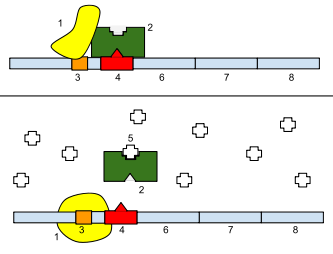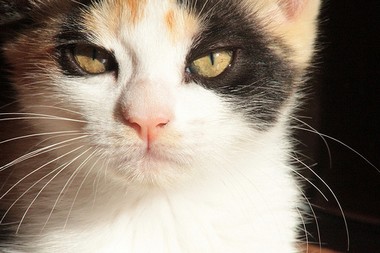Chapter 15: Regulation of Gene Activity
15.1 Prokaryote Regulation
Experiments with E. Coli showed that it is capable of regulating the expression of its genes
An operon consists of the following elements
1. Promoter - where RNA polymerase attaches, signalling the start of the gene
2. Operator - where repressor binds, stopping the transcription of that gene
3. Structural Genes - code for an enzyme, transcribed as a unit
Example: the trp Operon controls the production of tryptophan
Tying it altogether - the Lac Operon Gene
E. Coli bacteria can synthesize lactase, which is an enzyme that breaks down lactose. Lactase is only synthesized in the presence of lactose. If there is no lactose in the environment, the gene is repressed. Since they live in the intestinal tract of humans, they must live on whatever the host eats. When you drink milk, you are provided your E. Coli bacteria with lactose.
- E. Coli has three genes (6, 7, 8) that code for lactase.
- It also has a promoter (1) and an operator (2)
- Without lactose, the lac repressor binds to the operator site.
- With lactose (5), the repressor is removed
- Once repressor is removed, RNA polymerase binds to the promoter
- RNA is transcribed, the genes (6,7,8) code for lactase
Repressors turn transcription OFF(tryp operon)
Inducers turn transcription ON
(lac operon)
15.2 Eukaryote Regulation
In Eukaryotes, a variety of mechanisms regulate gene expression
1. chromatin structure
2. transcriptional control (operons)
3. post transcriptional control
4. translationslation control
5. post translational control
Chromatin Structure
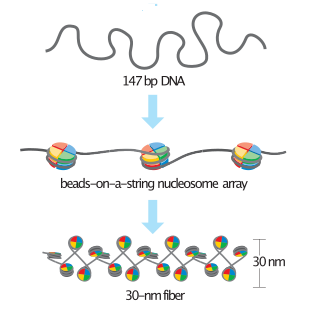
DNA is wound around a core of eight protein molecules, the result resembles beads on a string.
The protein molecules are histones and each individual bead is called a nucleosome
Histones form an octamer, made of approximately 147 base pairs.
Barr Bodies
Females have two X chromosomes, but it is believed that one of the inactivates. The expression of the genes located on the X chromosome depends on which X is active (random).
Calico cats have the patchwork color because the genes for black and orange colors are located on the X chromosome
Photo Credit: deadoll via Compfight cc
15.3 Gene Mutations
Point Mutation - substitute one base for another
Original: A T A C A C
Mutant : T T A C A CFrameshift Mutation - a base is either added or removed which causes a shift in the reading frame. Many genes affects
Original: A T A C A C A A G C C A
Mutant: A T T A C A C A A G C C ASilent Mutation - a base is changed but the resulting amino acid is the same as in the non mutant DNA. No outward changes.
Original: A A A C A G
Mutant: A A G C A GNonsense Mutation - a codon is changed to a STOP codon
Original: A T A C C C A A A
Mutant: A T T C C C A A A
Cancer
often results from a mutation in a TUMOR SUPPRESSOR GENE
Oncogenes activate causing uncontrollable cell division.
The BRCA (brak-uh) gene has been identified as the gene responsible for one type of breast cancer, it is located on Chromosome 17
Transposons
- Jumping Gene, a stretch of DNA that inserts itself into a different spot on a chromsome or another chromosome
*Mutations in DNA can cause a change in species --> Evolution
*HOX mutations can cause major changes in morphology
Epigenetics
See Learn.Genetics article
Genes become activated or inactived based on environmental triggers. These triggers may have occurred in previous generations.
Methyl is responsible for turning genes on an off (methylation)
The Homeobox
Homeobox containing, or "hox," genes are responsible for the big decisions of development rather than the details of engineering.
Fruit flies with a particular mutation in one of their many hox genes, for example, will develop an anatomically normal leg - in the spot where an antenna should be.
This mutation can also duplicate segments of the body, resulting in flies that have a double set of wings.
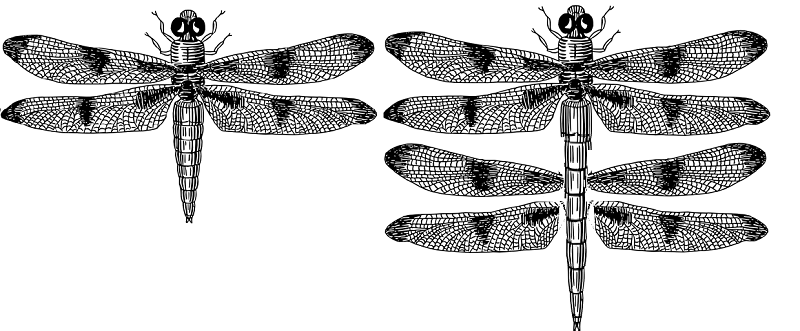
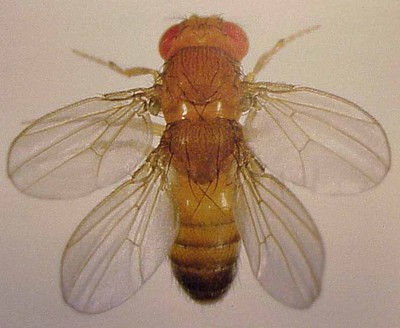
Drosophila with double wing mutation
